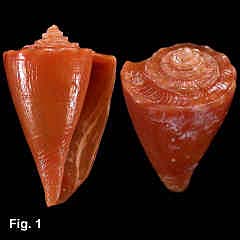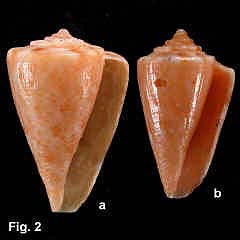|
|
|
|
|
Conus rutilus Menke, 1843 Description: Shell small, fragile, broad at the shoulder, sides straight or slightly convex. Body whorl with spiral ribs on the anterior quarter, remainder smooth. Shoulder roundly to sharply angled, nodulose or undulating, obsoletely so on some shells. Spire low; top of whorls concave, with curved axial growth lines; spiral sculpture absent. Colour uniformly or mottled pink or orange, less commonly yellow or purple, often with lines of alternating brown and white. Size: Up to 18 mm in length, commonly 8-12 mm. Distribution: Endemic to Australia; Clarence R, NSW to south-western Australia, including Tasmania. Habitat: Most specimens are taken as beach shells; rarely collected alive. Uncommon in NSW, more common in Victoria and SA. Comparison: Several authors have been reluctant to admit this shell as a full species, as its small size, fragile shell and thin lip suggests it is a juvenile form. However, in NSW at least, it is separable from juveniles of the three sympatric species, C. anemone, C. papilliferus and C. aplustre, by having a coronate shoulder and top of whorls concave and not spirally sculptured. C. anemone also has the entire body whorl spirally ribbed, even in juvenile shells, while C. rutilus is only so at the base. C. rutilus sometimes shows a colour pattern of dashed brown and white lines similar to C. aplustre, but the shells are easily separated by spire shape and sculpture. Pending further investigation, it appears to warrant inclusion as a full species. Synonymy: Conus smithi Angas, 1877 Fig. 1 Edithburgh, SA (C.unregistered) Fig. 2. a. Angourie, NSW (C.366278) b. Botany Bay, NSW (C.366313)
|

